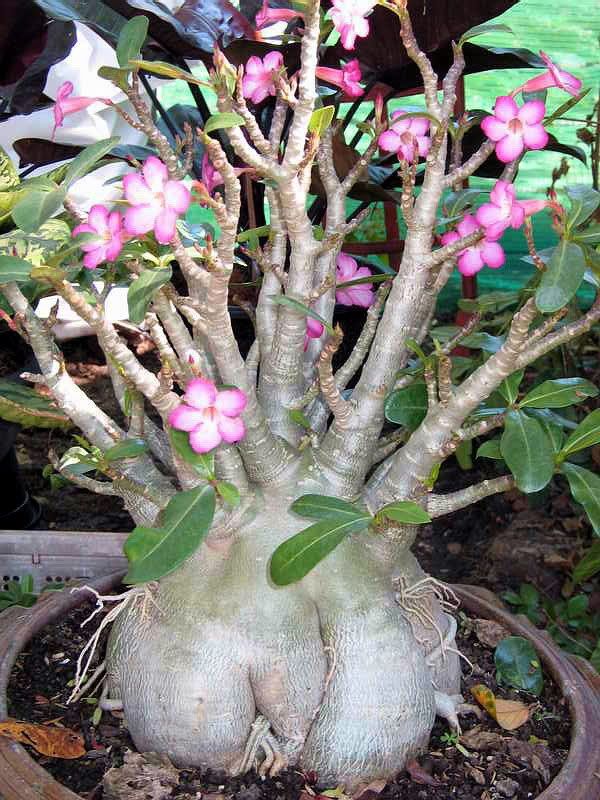A native of East Africa, the desert rose will grow from 6 ½ to 10 feet in the wild. It has fleshy leaves and beautiful 2-inch open-trumpet shaped flowers in shades from red to light pink.
Desert Rose is excellent in pots especially for people who "kill everything" because Adenium lives with little care and can take a good deal of neglect. Besides, the coolest Desert Rose plants are hybrids (many dozens of them) produced in China, Taiwan and Thailand, and some in India.
Watering: Needs little water during winter, especially when kept cool. Increase water during growing and blooming periods. If left without added water and no rain for a long time or after a cold night, your desert rose can lose most or all of its leaves. Never fear, they will re-grow after watering or after warm weather returns.
Soils: Good drainage is essential in any soil mix, yet the soil mix also must have moisture retention properties, along with adequate nutrients. Use a mixture of half potting soil and half perlite, which will hold some moisture but still drain nicely. If you live in a warmer climate where you can plant outdoors, you can use gravel instead of Perlite.
Repotting: Root prune and repot ever year or two, after the winter rest period, using a good draining soil mix such as described above. Peat can also be added to the mixture. Plant can tolerate being root-bound (tight in the pot.)
Pruning: Usually pruning is done to reduce overall plant size, or to selectively remove branches to 'sculpt' a more-perfect plant.
 |
| Adenium flower |
Fertilizer: Feed Adenium obesum with a general houseplant fertilizer half-strength about once or twice a month during the warm months. Blooming fertilizer may help encourage blooming during the growing season. Along with reducing watering to increase cold tolerance, fertilization should be ended in late August or early September. Availability of nutrients (especially nitrogen) encourages the plants to remain active and produce new growth.
Light: Adenium needs lots of light and fresh air. Keep in a bright location in winter. In summer plant can be moved outside and can tolerate full sun but partial or filtered sun is fine. Plant will bloom better if getting more full sun and regular water.
Temperature: Never below 40 degrees; however, in the winter, keeping it cool (between 40 and 61 degrees) gives the plant a needed rest.
Pest and Diseases: The common enemies of Desert Rose are aphids, caterpillars, sometimes scale insects and fungus. Bugs are pretty easy to handle if you observe and inspect your Desert Rose often ...you'll see the pests and can take action. Sometimes, the leaves are eaten by small worm. If the trouble is not serious, just remove the worm out of the plant.
Source: www.spicewoodspines.com, http://mgonline.com, www.ehow.com, www.tucsoncactus.org

7 comments:
Love the desert rose. It grows really well here in Tucson. It can take some strong sun in the morning but needs to be in the shade during the afternoon.....and when winter hits, it should be brought indoors. Slow growing, but one of the most beautiful plants around.
You have remarked very interesting points ! ps nice web site .
I have tried many other services but yours appeared to be the best. Lots of thanks.
Thank you. If you have anything to share or comment, please feel free.
Thank you for the informative post. :)
Hi i love your blog, i have just started a plant blog myself, http://plantlove88.blogspot.com/ i am new to alot of things and there is some really useful information on your blog thanks! i will keep following you for more useful tips :)
Hello, I started dealing in opuntia pads online. I have a pretty rare, cold hardy, spineless Cow's Tongue prickly pear plant.
Grows pads that average 20" and at times 30" plus. Just thought I would let you know. I enjoy reading your blog. email me for photos. jeaners127 @ gmail. com
Post a Comment